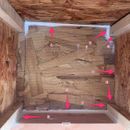Air sealing rim joist: am I doing this right?
Hi all –
Before I go doing all 40 floor joist/rim-board intersections, I thought I’d ask here: Does this look like a decent approach to air sealing this known-trouble-spot? In the worst of them, there is about a 1/16″ air gap (can see light through the crack marked “G”. In many/most of them, there is no visible crack.
I had considered taping from the exterior, but I’d go through hundreds of dollars of tape, and access is easier from inside (level slab vs. sloping muddy ground). That being said, it does seem like maybe it’d be wise and worth doing from the outside, depending on how many of these junctions need to be sealed.
I added letter-labels to this picture to make it easier to discuss.
I am using Tremco Dymonic 100 sealant.
GBA Detail Library
A collection of one thousand construction details organized by climate and house part










Replies
I would caulk the entire circumference regardless of any visual gaps.
Even if it's a internal to internal joint (including C,D,E,F).
It helps mitigate the effect of leakage and thermal bypasses if they do occur, by keeping them from spreading to adjacent bays.
You probably want some between the upper sheeting and top of joist going back a couple inches.
Is your rim joist just osb? Or is it an engineered piece like the floor joists.
The rim joist is a thick "OSB" (strand board?) beam. Its maybe 1.5" thick x 12" tall.
Understood. Thats a lot of caulking. Guess its time to get another audiobook!
I do think its worth doing, especially because I am installing hydronic radiant heat in these joist bays, so the temperature will be relatively high and leaks will have "extra waste power".
You may want to look at a glue injector for the gap between the top (or bottom) of the joist and the subfloor. That should have been glued by the builder. Urethane glue (gorilla glue) is messy to work with, but it foams up slightly on curing. You can inject a bead inside the joint and seal it from the inside. That stops cold air from running down the length of the joist and simply coming out farther into the house.
The alternate to the way you're doing it is to spray foam the entire band joist area, 1"-3" thick depending on your climate zone. You are still going to have to insulate the band with a vapor impermeable insulation. The spray foam does both insulating and air sealing in one pass. The glue injection is still a good idea with that approach, though. With spray foam, you're trading speed for cost. Your approach is cheap, but slow. More audiobooks.....